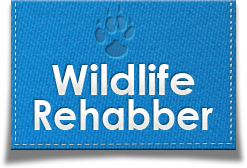If you find a baby bunny
UPDATE: An interactive tool is now available by visiting Found A Baby Bunny? Online Assessment Tool
Thank you for intervening on behalf of this baby. The fact that you have taken the first step will help ensure that this baby may have an opportunity to survive. Like you, wildlife rehabilitators volunteer to help wildlife when assistance would not normally be available.
When you first encounter an orphaned mammals, it is critical to ensure two things before deciding what action to take. First, is it injured or physically compromised. Next, is it truly orphaned?
First, screen the baby to see if it is injured or physically compromised. Please use every precaution to ensure your personal safety.
- Is it injured? Any evidence of blood in any amount, any signs of torn or punctured skin, breathing heavily, sitting or laying in an awkward position, arms/legs extended unusually, etc.
- Is it cold? They should feel very warm to the touch.
- Does it’s abdomen and eyes appear sunken-in? They should have bright round eyes and enormous pot-bellies.
- Is it lethargic, inactive, keeps its eyes closed most of the time, prefers to sleep, or is uninterested in it’s surroundings?
- Was it handled by a dog or cat/did you find it near a dog or cat?
- Is it in imminent danger (from children, pets, predators, traffic)?
- Are there dead siblings/parents near-by?
- Are there flies or ants around the baby?
- Possible fractures? When you gently extend arms and legs, the baby should be able to easily pull them back into proper position.
If you answered yes to any of these questions, please contact a Wildlife Rehabilitator immediately by phone. Medical intervention will most likely be needed. Please do not rely on email because most rehabilitators do not routinely access their computers. Visit Emergency Care for stabilization information until you can transport to a rehabilitator.
Is it really orphaned?
- Mothers leave the babies unattended ALL DAY, only to feed them at pre-dawn and after dusk. You will NEVER see the mother; she only feeds them between dusk and pre-dawn to avoid attracting predators.
 In the eastern United States, baby bunnies that are larger than a softball (5 inches in length) are already independent of their mother. They should be returned to a spot close to where they were found with dense foilage in which they can hide. Keep all pets and other activities away from this area.
In the eastern United States, baby bunnies that are larger than a softball (5 inches in length) are already independent of their mother. They should be returned to a spot close to where they were found with dense foilage in which they can hide. Keep all pets and other activities away from this area.
- Healthy, uninjured babies should be returned to the nest. The “nest” will look like a shallow depression sparsely lined with the mother’s belly fur and grasses. It is usually located in high grasses, under bushes, or in flower beds. Return the babies to the nest and lightly cover them with the fur and grasses. They will usually stay put if they feel adequately hidden.
If you need to mow or work near an active bunny nest, consider covering the nest with a laundry basket to prevent causing injury to the babies or having the babies “bolt” in fear.
You can protect active nests in your yard by enclosing them with 2×4 or 4×4 inch wire to exclude children and pets. The openings will still be large enough for mom to reach the babies.
A successful bunny renest is determined by checking on the babies during the next 3 mornings, during which you should be able to see a “milk line” at the tummy showing that the babies were fed. Please note, we no longer recommend using twigs, string, or flour on or around the nest. This is not an absolute for ensuring that the babies are still healthy and being fed. You can have a very high renest success rate when you follow these instructions.
- Additional information can be found in the Bunny Brochure.
- If a renest has been unsuccessful or the baby’s condition deteriorates, please contact a Wildlife Rehabilitator immediately by phone. Medical intervention will most likely be needed. Please do not rely on email because most rehabilitators do not routinely access their computers. Visit Emergency Care for stabilization information until you can transport to a rehabilitator.
 This nest of bunnies was discovered by a homeowner who suspected her dog had killed the mother. The babies did not have plum
This nest of bunnies was discovered by a homeowner who suspected her dog had killed the mother. The babies did not have plum p round bellies nor a visible milk line (meaning they hadn’t been fed by mom recently). When she held them on their back to check their stomach, their abdomens were sunken in and their skin was wrinkled. They were taken to a wildlife rehabilitator where they received treatment for dehydration and were raised until old enough for release.
p round bellies nor a visible milk line (meaning they hadn’t been fed by mom recently). When she held them on their back to check their stomach, their abdomens were sunken in and their skin was wrinkled. They were taken to a wildlife rehabilitator where they received treatment for dehydration and were raised until old enough for release.





